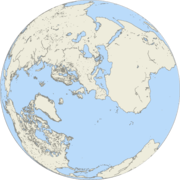Hemispheres of Earth
Appearance

The Hemispheres of the Earth in geography and cartography refer to any division of the globe into two hemispheres (from Ancient Greek [ἡμισφαίριον hēmisphairion] Error: {{Lang}}: text has italic markup (help) meaning "half of a sphere").
The most common such divisions are by latitudinal or longitudinal markers:
- North-South
- Northern Hemisphere, the half that is north of the equator
- Southern Hemisphere, the half that lies south of the equator
- East-West
- Eastern Hemisphere, the half that lies east of the prime meridian and west of the 180th meridian
- Western Hemisphere, the half that lies west of the prime meridian and east of the 180th meridian
The East-West division can also be seen in a cultural sense, as a division into two cultural hemispheres.
However, other schemes have sought to divide the planet in a way that maximizes the preponderance of one geographic feature or another in each division:
- Land-Water
- Land hemisphere, the hemisphere on the Earth containing the largest possible area of land
- Water hemisphere, the hemisphere on the Earth containing the largest area of water
See also
References
External links
![]() Media related to Earth's hemispheres at Wikimedia Commons
Media related to Earth's hemispheres at Wikimedia Commons




